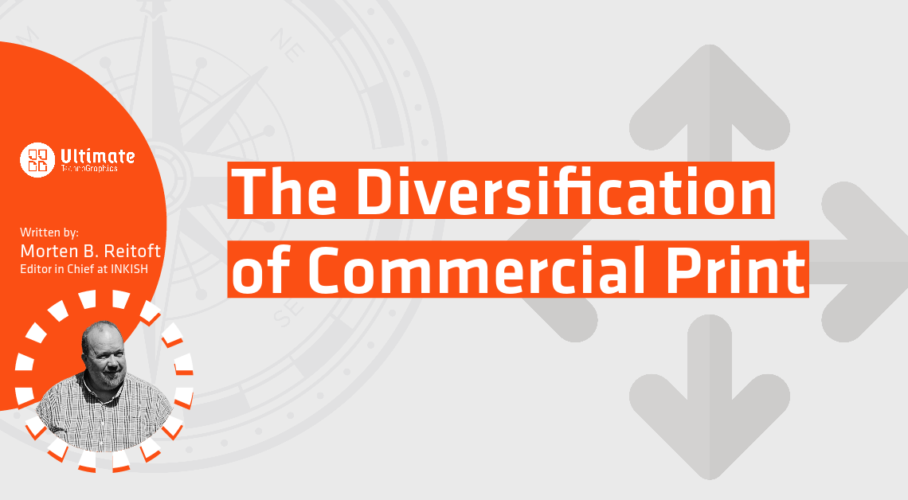I’ve already written about this topic, but good things can not be repeated too often. To re-cap. If you are running a commercial printing company, you may have experienced a drop in sales on certain products, so looking into other products and services isn’t new to you, but what should you be looking into?
There are quite a few answers to that question, so let’s dive in:
1) You can specialize within the commercial print segment
2) You can insource productions that today are outsourced
3) You can acquire complementing companies
4) You can diversify your product offerings
5) You can rethink your entire business model (which is always good)
6) and probably more …
Let’s look into the above points and see if you agree.
1) An enormous number of products characterizes commercial print continuously produced one by one. Every morning, a printing company starts the machines to produce books, magazines, brochures, catalogs, posters, business cards, letterheads, and more. You are a company able to deliver almost everything your customer requires. You are quite good at it. Otherwise, competition would soon outperform you, so it requires workflow automation, streamlined production, and an overall volume to keep the investment profitable regardless of the volume of each job. Margins are stressed, and there is the ever expanding competition for the lowest prices in the market – also known as democratization of prices.
If you continue on this path, volume and efficiency is the key!
However, consider specializing. Pick a product or a service, ensure you become the best in the niche, and set margins to be profitable on a lower volume. The niche can be almost anything, and if you look at successful niche players, moo.com is a brilliant example. Focusing on high-quality business cards, they have the margin, and with an extreme focus, they have built a business quite unique. I am not the one to tell you which niche you should address, but if you become the leader in a particular niche, what happens is typically that you’ll get customers from a more extensive geography. I am sure this is the route for many commercial printers today! We can’t all be commodity printers only focusing on volume!
2) Many commercial printers outsource part of their production today. It can be certain types of binding or embellishment, but it can also be based on certain commodity products or specialty products that the printer cannot produce. It’s not all outsourced business that is valuable to insource. Still, looking at all your outsourced services over time, you might see a picture of what services could be valuable to insource. When you insource, what often happens is that you build expertise on that type of product/service, and if it’s a product with excellent margins, focus on this, market it, and grow on it. You know the margins on outsourcing is a matter of reaching critical mass. I remember I was once in a filming session with Franz Repp from Scodix. He and his team made a calculator where you enter the number of outsourced embellishment jobs a year and the cost. Then, the spreadsheet gave you a clear idea of whether an investment could be attractive – a great option for a commercial printing company to look into!
3) Acquiring other companies is quite a big task, but a great work to explore as an option is finding companies to partner with. It might be part of generational sales, but it could also be because sometimes organic growth takes too long. When I write about it in the context of diversification, think of this as an option that will give you faster access to an existing market. Be aware that acquiring a company that suffers, can be overwhelming, and it may be better not to pursue it. You can also argue that healthy companies are too expensive to buy. Still, in every company life cycle, there should be opportunities that can shortcut your growth and diversification!
4) As mentioned in my previous blog post about product diversification, you must serve your customers’ needs. If customers are no longer demanding your products, you must provide products in demand OR specialize to create a larger market for your niche. Many commercial printers today have already diversified their offerings – and you see many selling wide-format products and even entering into folding carton packaging – for good reasons. With the change in demand, so do margins change as well!
5) Rethinking your entire business is a challenge – but as customers, demand, and surroundings constantly change, the status quo is really not an option, so rethinking your business model is an exercise in understanding whether you are on the right track. If you are profitable, you are on the right path; if not, you must rethink your business!
6) There are ALWAYS other ways to make your business more profitable.
Regardless of all of the above, you can be sure that to ensure your future business workflow automation is not an option. You must automate your business, consider where your customers are, and how to reach them in your communication and product offerings.”
Author: Morten B. Reitoft
Editor in Chief at INKISH

